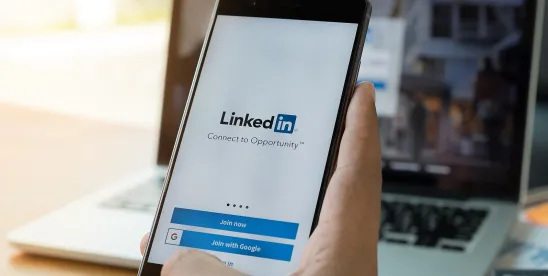LinkedIn, the world’s largest online professional network, is the place for lawyers at every level to harness its brand building, network building and business building powers. However, just having a LinkedIn profile is no longer enough to be successful on LinkedIn. To fully leverage LinkedIn to your advantage and take advantage of the myriad opportunities it offers requires a strong foundation, presence and network. Here’s how to maximize your professional impact using LinkedIn.
1 – Build a Standout Profile
Your LinkedIn profile is your digital business card, resume and personal pitch rolled into one. To make a strong first impression:
- Complete Your Profile: Ensure your profile is 100% complete, featuring a professional photo, a compelling headline and a detailed summary (your bio). Highlight your skills, experiences and achievements.
- Optimize for SEO: Use relevant keywords in your profile to make it more discoverable. This includes your headline, summary and job descriptions.
- Eye-Catching Cover Image: Make sure your cover image is optimized, includes your contact information and promotes any key initiatives.
2 – Network with Intention
Networking on LinkedIn goes beyond simply amassing connections; it’s about cultivating meaningful and impactful relationships:
- Connect with Purpose: Strategically reach out to colleagues, former colleagues, industry peer, and thought leaders. When sending connection requests, personalize your message to explain why you want to connect and how you can provide value.
- Engage Thoughtfully: Consistently comment, share and post insightful content. This not only boosts your visibility but also positions you as a knowledgeable and active participant in your field. Respond to others’ posts with meaningful comments that add value to the discussion, showing that you are engaged and informed.
- Leverage Content to Showcase Expertise: Regularly share articles, industry news and your own insights on relevant topics. Write LinkedIn articles to delve deeper into subjects you’re passionate about, demonstrating your expertise and thought leadership.
- Participate in Groups: Join LinkedIn groups related to your industry. Participate actively by sharing content, commenting on discussions and connecting with other group members. This can significantly expand your network and establish your presence in your professional community.
- Host and Attend LinkedIn Events: Engage with your network by hosting webinars, Q&A sessions or virtual meetups. Attend events hosted by others to expand your knowledge and network.
3 – Share and Create Valuable Content
Content that adds value to your network will engage your connections and amplify your professional reputation. Here are several ways to ensure your content stands out:
- Share Insights: Regularly post articles, updates about your professional achievements and write original pieces. Share industry news, legal updates and your perspective on recent developments. By offering unique insights, you can establish yourself as a thought leader in your field.
- Consistency Over Quantity: Prioritize consistency in your posting schedule. Focus on quality over quantity to ensure each piece of content is well-researched and thoughtfully crafted. Regular, high-quality posts keep your network engaged and looking forward to your insights.
- Use Multimedia: Enhance your posts with visuals, such as infographics, videos and images. These formats are more engaging and can help illustrate complex ideas more clearly. For instance, a short video explaining a recent legal change can be more impactful than a text post.
- Create Long-Form Content: Write detailed LinkedIn articles on relevant topics. These articles allow you to dive deeper into subjects and provide substantial value to your audience. Use them to share in-depth analyses, case studies or comprehensive guides.
- Engage with Trending Topics: Stay updated with current trends and participate in ongoing discussions. Adding your voice to trending topics can increase your visibility and show that you are engaged with the latest developments in your industry.
- Interactive Content: Create polls, ask questions and encourage discussions. Interactive content not only engages your audience but also provides valuable feedback and insights that you can use to tailor future posts.
- Highlight Achievements and Case Studies: Showcase your professional achievements, successful case studies and client testimonials. Highlighting real-world successes builds credibility and demonstrates your expertise.
- Collaborate with Influencers: Partner with industry influencers to co-author articles, participate in webinars or conduct interviews. These collaborations can expand your reach and bring additional credibility to your content.
- Educational Series: Develop a series of posts or articles that educate your audience on specific topics. This could be a series on recent regulatory changes, best practices in healthcare M&A, or common legal pitfalls and how to avoid them.
- Curate Content: Share relevant articles and insights from other thought leaders in your field. Adding your commentary to these shares can show your engagement with the broader industry and position you as a well-rounded expert.
5 – Engage with Industry Groups
LinkedIn Groups offer a unique platform for lawyers to engage with peers, share insights, and stay informed about industry trends. Here’s how to maximize the benefits of joining and participating in relevant groups:
Join Relevant Groups
- Engage in Discussions: Actively participate in group discussions by commenting on posts, asking questions, and sharing your expertise. This positions you as a thought leader and builds your professional reputation within the group.
- Share Insights: Regularly share valuable insights, articles and resources related to your field. By providing useful information, you can establish yourself as a knowledgeable and helpful member of the community.
- Connect with Like-Minded Professionals: Use the group as a networking tool to connect with other professionals who share similar interests. This can lead to collaborative opportunities and professional growth.
Discover Opportunities
- Find Job Opportunities: Many LinkedIn Groups have job boards or members who post job openings. Staying active in these groups can help you learn about new career opportunities before they are widely advertised.
- Expand Your Network: Groups are an excellent way to meet new contacts who can offer fresh perspectives, potential referrals, and collaborative opportunities. Engaging with a diverse group of professionals can significantly expand your network.
- Stay Updated on Industry Trends: Groups often discuss the latest trends and developments in your field. By staying engaged, you can keep abreast of these trends and apply new insights to your practice.
- Join Alumni Groups: Engage with alumni groups from your law school or former employers. These groups offer a common ground for reconnecting and can be a valuable resource for career advice, mentorship and professional opportunities.
- Participate in Events: Many groups host events, webinars and virtual meetups. Participating in these events can help you build stronger relationships with group members and stay engaged with the community.
- Mentorship and Advice: Alumni and professional groups can provide mentorship opportunities. Experienced professionals in these groups can offer guidance and advice that can be invaluable for career development and navigating complex legal landscapes.
6 – Use LinkedIn for Research
LinkedIn is a valuable resource for gathering comprehensive information on clients, competitors and industry trends. By preparing thoroughly and making informed decisions based on LinkedIn insights, lawyers can gain a strategic advantage.
1. Prepare Thoroughly
- Research Companies: Use LinkedIn to delve into the profiles of companies in which you’re interested. Understand their business model, recent activities and strategic priorities. Look at their LinkedIn page to see updates, company news and employee posts.
- Understand Company Culture: Analyze the content shared by the company and its employees to get a sense of the company culture. This can provide insights into their values, work environment and operational style.
- Identify Key Decision-Makers: Identify and research key decision-makers within the organization. This includes executives, department heads and other influential figures. Understanding their background, interests and professional journey can help tailor your approach when reaching out or negotiating.
2. Make Informed Decisions
- Prepare for Job Interviews: Use LinkedIn to research potential employers, understand their expectations, and tailor your application and interview responses accordingly. Review the profiles of interviewers to find common ground and prepare relevant questions.
- Career Changes: If considering a career change, LinkedIn can help you understand the landscape of the new field, identify required skills and network with professionals already established in that industry.
- Business Partnerships: Before entering into partnerships, use LinkedIn to assess potential partners’ credibility and their network. Look at their endorsements, recommendations and shared content to gauge their reputation and expertise.
3. Monitor Competitors
- Track Competitor Activities: Follow competitor companies and their key employees to stay updated on their latest developments, product launches and strategic moves. This can provide valuable insights into market trends and competitive dynamics.
- Benchmarking: Compare your firm’s LinkedIn presence, content strategy and engagement metrics with those of competitors to identify areas for improvement.
4. Industry Trends and Insights
- Join Industry Groups: Participate in LinkedIn groups related to your practice areas. These groups can provide insights into current trends, challenges and opportunities within the industry.
- Follow Influencers: Identify and follow industry influencers and thought leaders. Their posts and shared content can keep you updated on the latest trends and best practices.
5. Client Engagement and Relationship Building
- Client Updates: Keep track of clients’ professional updates, such as promotions, job changes or new projects. Congratulate them on milestones to strengthen relationships.
- Content Engagement: Engage with clients’ posts by liking, commenting and sharing. This shows your active interest in their work and helps maintain a consistent presence in their network.
6. Networking and Lead Generation
- Expand Your Network: Use LinkedIn to connect with potential clients, industry peers and other professionals who can provide referrals or business opportunities. Send personalized connection requests to make a strong first impression.
- Lead Generation: Use LinkedIn’s advanced search filters to find and connect with potential leads. Participate in discussions and share relevant content to establish credibility and attract prospects.
Practical Tips for How Busy Lawyers Can Use LinkedIn
- Schedule Regular LinkedIn Time: Allocate specific times in your weekly schedule to update your LinkedIn profile, engage with content and conduct research. Even 15 minutes a day can make a significant impact.
- Use LinkedIn Tools: Utilize LinkedIn’s tools such as Sales Navigator for advanced search capabilities and Lead Gen Forms to capture leads directly from your content.
- Automate Content Sharing: Use tools like Hootsuite, Sprout Social or Buffer to schedule posts in advance. This ensures consistent activity on your profile without daily effort.
- Delegate Tasks: Delegate LinkedIn research and routine engagement tasks to a junior associate or marketing team member, freeing up your time for high-value activities.
- Utilize LinkedIn Mobile App: Use the LinkedIn mobile app to stay engaged on the go. This allows you to quickly respond to messages, engage with content and stay updated on network activities.
Key Takeaways
- Optimize Your Profile: Treat your LinkedIn profile as a comprehensive introduction to your professional self.
- Intentional Networking: Build meaningful connections and engage actively with your network’s content.
- Content Creation and Sharing: Share valuable content consistently to establish thought leadership.
- Continuous Learning: Utilize LinkedIn Learning to demonstrate your commitment to professional development.
- Industry Group Engagement: Participate in relevant groups to stay informed and connect with peers.
- Strategic Research: Use LinkedIn for research to make informed career and business decisions.
Next Steps
- Profile Audit: Review and update your LinkedIn profile to ensure it accurately reflects your professional background, skills and achievements.
- Networking Plan: Identify at least five industry leaders or peers to connect with and plan how you will engage with their content.
- Content Calendar: Create a content calendar for the next month, outlining what and when you plan to post.
- Skill Development: Choose one course on LinkedIn Learning to complete and add this skill to your profile upon completion.
- Group Participation: Join two industry-related LinkedIn groups and actively participate in discussions at least once a week.
- Research Activity: Conduct research on a company or industry trend and share your insights in a LinkedIn post.
Implementing these strategies and completing the next steps will significantly enhance your LinkedIn presence, ensuring you’re fully leveraging the platform for your professional advancement. Remember, the effort you put into LinkedIn is directly proportional to the opportunities and benefits you’ll receive.




 />i
/>i

